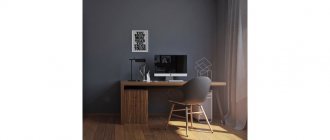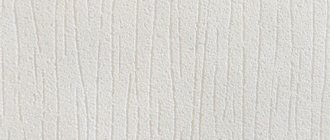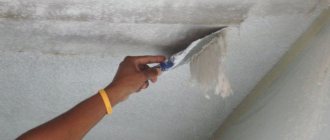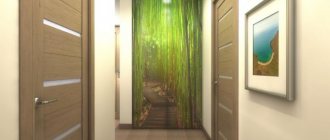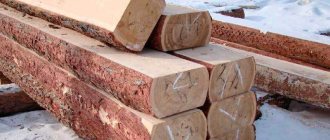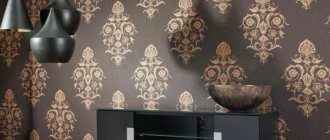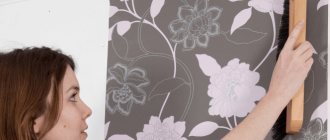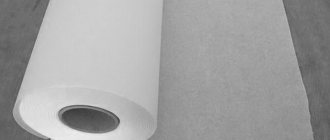Paintable wallpaper: features
It is believed that wallpaper is the most popular material for wall decoration. This is due to their low cost, ease of use, and ease of maintenance.
Well, those that could be repainted in different colors are a real find. In most cases, this material is completely white, and only in 3-5% of cases do manufacturers produce colored specimens. As a rule, they all have an interesting structured pattern, which allows them to look great in the interior.
All products of this type can be repainted several times. It is very comfortable. Tired of one color or decide to update your furniture? Cosmetic repairs and complete renovation of the room will not be difficult.
Advantages
Among the many advantages, several common ones can be identified:
- Possibility of gluing on uneven walls with defects;
- Coloring up to seven to ten times is acceptable, without loss of texture;
- Moisture resistance and fire resistance are achieved by treatment with special impregnations;
- The embodiment of any interior ideas;
- They allow air to pass through, thereby not affecting the microclimate of the room;
- Resistance to deformation, stretching;
- Easy to care for;
- Easy to paste - end-to-end.
Fiberglass wallpaper for painting
This material is particularly durable. It is made from several components:
- caustic soda;
- quartz sand;
- dolomite;
- lime.
The result is fiberglass that is resistant to external influences.
Pros:
Increased wear resistance of both the base and coating.
Convenient to stick on walls.
The material is not flammable.
Easy to care for, washable with a brush, recommended for public spaces.
Minuses:
- Relatively high cost compared to other types.
- The drawing is not clearly expressed.
- They require preparation of walls for pasting, as well as special protective materials when working with them.
- Difficult to remove from the wall during dismantling.
ADVICE! THE QUESTION ABOUT WHAT IS BETTER FOR PAINTING, GLASS WALLPAPERS OR NON-FLISH WALLPAPERS, CANNOT BE ANSWERED UNIQUELY. WE ADVISE YOU TO CHOOSE FIBER GLASS MATERIALS FOR CHILDREN'S AND LIVING ROOMS, AND IN OTHER CASES BE GUIDED BY YOUR OWN TASTE AND FINANCIAL CAPABILITIES.
Types of coating
Paint may differ not only in composition. The material covers and looks different on the walls. Below we consider several types of coverage:
Glossy
The reflected light creates a sophisticated shine and adds natural light to the room. For darkened rooms located on the north side, this is an excellent design solution. On smooth walls, glossy coating looks most impressive. There is another plus: gloss visually enlarges the space, so gloss is perfect for small rooms.
Semi-gloss
A universal option for any premises. However, before applying the solution, you need to carefully level the walls. They are best used for coloring paper or glass wallpaper.
Matte
The matte finish looks aesthetically pleasing and elegant. It creates a calm and peaceful environment, so these paints are great for painting bedrooms and living rooms. Another advantage is its ability to hide uneven surfaces.
Paper models
This option will suit those who want to save a lot on cosmetic repairs. Paper ones were widespread in our parents' apartments. They consist of two layers of paper. In order for the wallpaper to have texture, an embossing method using wood chips is used.
Pros:
- Environmentally friendly, breathable material.
- They have low cost.
- Hides minor wall defects.
Minuses:
- They may tear during operation.
- They deform when the walls shrink.
- They are considered the least durable of all types of wallpaper.
- The service life is no more than 5 years.
Paintable vinyl wallpaper on non-woven backing
As we said earlier, the most common coating for non-woven backing is vinyl. This material itself is fragile; over time it dries out and crumbles. That is why such wallpapers must be painted. Paint creates not only color, but also a protective layer.
Evgeniy Filimonov
Ask a Question
Vinyl is a coating made from polyvinyl chloride. It is also applied to a paper base. Vinyl can be easily wiped clean with a damp cloth. The service life of such material is up to 6 years.
Anti-vandal wallpaper for painting
Separately, I would like to talk about wallpaper that has anti-vandal properties. Their advantage is that they are able to withstand mechanical stress. Such material will come in handy in homes where there are small children or pets.
This property is ensured by a special dense vinyl layer. The possibility of repeated repainting is an additional advantage of the material. An example of high European quality is the German anti-vandal paintable wallpaper Erfurt. They also have an interesting texture.
Choosing material
Often, when choosing wallpaper, the least attention is paid to what it is made of. This is not entirely correct, because not all types are suitable for painting. However, some are best painted no more than once, while some can change their color up to 15 times. Therefore, we will consider all existing materials, and also try to choose the best option that will withstand subsequent processing without problems.
Wallpaper, which can later be used for painting, comes in the following types:
- Paper (often only duplex, consisting of two layers). It is best to choose special types that are additionally impregnated with water-repellent compounds, because this allows them to maintain their appearance even after several paintings.
- Vinyl (vinyl coating is applied to the paper). Often the opinions of specialists on this type differ. Some of them argue that it is better not to repaint such wallpaper because it lacks strength. Despite this, foamed vinyl can withstand increased impact, and therefore is suitable for painting, as the manufacturers themselves say. Therefore, you can use them taking into account all the recommendations.
- Non-woven (produced by combining cellulose, durable textile fibers, binder polymers). Due to their strength and a large number of textures, they are ideal for further processing; they allow steam and air to pass through, and therefore do not accumulate excess moisture. Now they are commonly used everywhere.
- Glass wallpaper (made from mineral components). They have increased strength due to the use of fiberglass threads. You can choose such wallpaper when you want to hang something unusual with a relief texture. At the same time, they are ideal for painting, because they can be covered with coloring compounds up to 10-15 times.
- There are other types of wallpaper (textile, cork, “liquid” and metallized), but these options, although they have an original appearance and fit perfectly into the interior, are not used for painting.
Which wallpaper for painting is better to choose?
The choice of finishing material is difficult, even when it comes to wallpaper.
When purchasing, you should pay attention to the following details:
- price;
- strength;
- roll width;
- appearance.
Breathable materials are chosen for children's rooms and living rooms; for walkways, especially hallways, materials with a durable surface are chosen. If anti-vandal wallpaper seems expensive to you, feel free to choose fiberglass, which has proven itself well in use.
The paper-based material will last the least, followed by the classic non-woven ones. The most durable options are considered to be fiberglass, as well as anti-vandal wallpaper, which have no competition. Today, meter-wide rolls are increasingly used, which are used to cover walls faster, and besides, the design looks perfect, because in this case there are fewer joints.
Five burning questions
| Question | Answer |
| Question No. 1. How long before you can paint wallpaper after gluing it? | Not earlier than in 2 days. |
| Question No. 2. Do I need a primer before gluing? | If you are gluing onto clean plaster, then it is necessary to prime it a couple of times. If wallpaper has already been pasted on the wall, then once is enough.
|
| Question No. 3. Is it possible to paint non-woven wallpaper with oil paint? | It’s possible, but not with regular polish, where the dye is ground too coarse, but with compounds intended for artistic work. And first check the paint for the presence of solvents, just apply it to a piece of non-woven wallpaper and wait a couple of days. |
| Question No. 4. Which roller is best to use for painting? | Foam rubber is absolutely not suitable, there will be small bubbles. Then everything depends on the depth of the texture. For a standard texture, take a roller with short pile; the deeper the texture, the longer the pile. |
| Question No. 5. Why does the paint smear? | Even expensive paints can smear slightly in the first 3–4 weeks, especially in high humidity conditions, for example in the kitchen. If even a month after the repair the paint still appears, it means that they have given you a fake. |
If you highlight the texture with paint, the wallpaper will look completely different.
How to glue wallpaper for painting: progress and nuances
We will tell you and clearly show you how to glue non-woven wallpaper for painting. Using their example, you can learn about the nuances of work. The first step is to close all the windows and preferably even the doors, since they are afraid of drafts.
For work you will need the following materials and tools:
- glue (special or PVA);
- wallpaper;
- pencil;
- primer;
- roulette;
- sharp knife;
- wallpaper smoother;
- wide brush for primer and glue;
- long ruler.
Evgeniy Filimonov
Ask a Question
There is no need to specifically level the walls for painting. We will show photos of the interior below. The paint will hide all the little things. Before starting work, the surface is thoroughly primed.
To do this, choose a high-quality primer. You can walk 2-3 times to improve adhesion. We also dilute the glue, it should be thicker than usual.
There are two types of wallpaper:
- without selecting a pattern;
- with a selection of designs.
If working with the first option is not difficult, then the second makes a person think. In fact, choosing a pattern should not be difficult. Take a look at the packaging; in addition to dry information, it contains a fitting map. It also indicates after what number of centimeters the pattern is repeated again. When cutting, you just have to shift the new sheet onto this segment.
Description of works:
- Measure the height of the walls and cut the wallpaper into pieces using a ruler, pencil and tape measure.
- Glue the sheets starting from the window or the far corner of the room. Take a tape measure and measure from the corner on the right a distance equal to the width of the roll. We put a mark with a simple pencil.
- Apply glue to the area where the first sheet will be glued. There should be no gaps left without glue.
- A sheet is taken and aligned along the line that was previously placed on the wall along the width of the sheet. The sheets are glued dry; only the wall is covered with glue.
- After leveling, iron with a smoothing iron. Smooth out from left to right slowly, piece by piece.
- If a pipe is adjacent to the wall, there are boxes and sockets available, then using a sharp knife these obstacles are bypassed on the spot.
Then they move forward in the same way. Measure the distance, put a mark and determine the line. Only now smoothing is done from the joint, going to the left. Everything is ready, all that remains is to paint the walls. However, first you need to choose the right paint.
Pasting process
First of all, you need to prepare the surface, remove the old coating and putty the wall. Dilute the glue in the specified proportions and leave for the required time. The adhesive solution is chosen specifically for non-woven and heavy wallpaper. Cut strips from a single roll with a small margin of 10-20 centimeters, taking into account the adjustment of the pattern, if any. Make marks on the walls using a plumb line and a pencil to guide the application of the strip.
Non-woven wallpaper is good because it does not deform when glued and lies evenly. The glue needs to be applied only to the wall, making the entire repair process easier. Then it is applied over a previously prepared section of wallpaper and smoothed using a special roller, expelling all the air. The second strip is applied at the joint, without overlap, this ensures an even fit without visible seams. Finally, leave the room to dry completely.
Also read: Cork wallpaper; main characteristics and methods of gluing
Which wallpaper paint is better for painting?
For each type of material, its own paint is selected. All of them belong to the category of water-dispersed. Its color is the client’s desire:
• for paper and non-woven bases – water-based paint;
• for glass wallpaper - acrylic or latex, to choose from.
This rule is not fundamental. The most popular paint is acrylic. It should be noted that it can also be used to paint non-woven material. Its main advantage is the absence of fear of moisture. The downside of acrylic paint is the dullness of the shades. It will not be possible to make the surface glossy.
Color is chosen with care. It must match the texture and purpose of the room. We also advise you to pay attention to the paint base, its composition and characteristics.
A good paint should have the following parameters:
- high density;
- moisture resistance;
- environmental friendliness;
- short drying period;
- lack of odor or have a slight odor;
- vapor permeability.
Evgeniy Filimonov
Ask a Question
Latex paint protects the vinyl texture well. It can also be used for non-woven bases. Alkyd paint will reliably protect the surface, but it will not allow the walls to breathe and is unsuitable for use in bathrooms, children's rooms and living rooms.
Characteristics; advantages and disadvantages
Both options offer a durable coating that is ready to last for years, with the ability to update the texture, which means that with minimal investment you can get the maximum benefit and enjoy a delightful interior.
Advantages
- The ability to update the texture and change the color will ensure long-term use of the material without unnecessary investments.
- Moisture resistance and washability allow the fabric to be used in rooms with an aggressive microclimate.
- The elasticity of the material will protect against possible tears, so they can be safely glued in new buildings.
- Models made entirely of non-woven fabric have good throughput and are safe for humans.
- The ability to mask small and insignificant defects in walls facilitates the installation process.
- Easy installation, do it yourself; apply glue only to the wall.
- Quick dismantling, the coating can be removed in one click.
- They do not electrify and do not attract dust.
Flaws
- Vinyl trellises do not allow air to pass through, blocking natural air vapor circulation.
- Both types of wallpaper support combustion, while vinyl ones emit toxic fumes.
- Prices for the material are quite high.
Experts and finishers recommend using models made entirely from non-woven fabric to decorate a bedroom or children's room. Vinyl, taking into account their shortcomings, can be glued in large rooms or used in fragments. Both canvases are practical for any type of room and adaptable to any microclimate.
How to properly paint wallpaper for painting
It's time to start painting. This process is simple, but has a number of important nuances. The doors and windows are first covered with masking tape, and the floor is covered. For painting, use a velor roller of any convenient width. It will ensure the correct consumption of material.
Description of works:
- Mix the paint with a mixer.
- If there are defects at the joints, fill them with acrylic, and then remove the excess with a rag.
- Start painting from corners and slopes using a brush.
- Now you can paint the walls with a roller. Don't leave any drips.
- When the first layer of paint has dried, paint the second layer according to the same principle.
Based on materials from the site: homemyhome.ru
